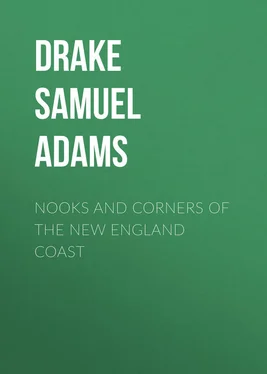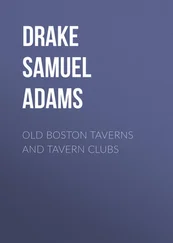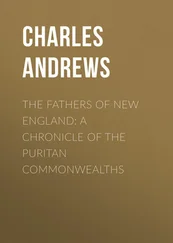Samuel Drake - Nooks and Corners of the New England Coast
Здесь есть возможность читать онлайн «Samuel Drake - Nooks and Corners of the New England Coast» — ознакомительный отрывок электронной книги совершенно бесплатно, а после прочтения отрывка купить полную версию. В некоторых случаях можно слушать аудио, скачать через торрент в формате fb2 и присутствует краткое содержание. Жанр: foreign_antique, foreign_prose, на английском языке. Описание произведения, (предисловие) а так же отзывы посетителей доступны на портале библиотеки ЛибКат.
- Название:Nooks and Corners of the New England Coast
- Автор:
- Жанр:
- Год:неизвестен
- ISBN:нет данных
- Рейтинг книги:3 / 5. Голосов: 1
-
Избранное:Добавить в избранное
- Отзывы:
-
Ваша оценка:
- 60
- 1
- 2
- 3
- 4
- 5
Nooks and Corners of the New England Coast: краткое содержание, описание и аннотация
Предлагаем к чтению аннотацию, описание, краткое содержание или предисловие (зависит от того, что написал сам автор книги «Nooks and Corners of the New England Coast»). Если вы не нашли необходимую информацию о книге — напишите в комментариях, мы постараемся отыскать её.
Nooks and Corners of the New England Coast — читать онлайн ознакомительный отрывок
Ниже представлен текст книги, разбитый по страницам. Система сохранения места последней прочитанной страницы, позволяет с удобством читать онлайн бесплатно книгу «Nooks and Corners of the New England Coast», без необходимости каждый раз заново искать на чём Вы остановились. Поставьте закладку, и сможете в любой момент перейти на страницу, на которой закончили чтение.
Интервал:
Закладка:
Mine host of the village tavern, Daniel Somes, or "Old Uncle Daniel," as he is known far and near, is the grandson of the first settler of the name who emigrated from Gloucester, Massachusetts, and "squatted" here – "a vile phrase" – about 1760. Abraham Somes built on the little point of land in front of the tavern-door, from which a clump of shrubs may be seen growing near the spot. Other settlers came from Cape Cod, and were located at Hull's and other coves about the island. I asked my landlord if there were any family traditions relative to the short-lived settlement of the French, or traces of an occupation that might well have set his ancestors talking. He shook his gray head in emphatic negative. Had I asked him for "Tam O'Shanter" or the "Brigs of Ayr," he would have given it to me stanza for stanza.
There are few excursions to be made within a certain radius of Somesville that offer so much of variety and interest as that on the western side of the Sound, pursuing, with such wanderings as fancy may suggest, the well-beaten road to South-west Harbor. It is seven miles of hill and dale, lake and stream, with a succession of charming views constantly unfolding themselves before you. And here I may remark that the roads on the island are generally good, and easily followed.
The map may have so far introduced the island to the reader that he will be able to trace the route along the side of Robinson's Mountain, which is between the road and the Sound, with two summits of nearly equal height, rising six hundred and forty and six hundred and eighty feet above it. At the right, in descending this road, is Echo Lake, a superb piece of water, having Beech Mountain at its foot. You stumble on it, as it were, unawares, and enjoy the surprise all the more for it. Broad-shouldered and deep-chested mountains wall in the reservoirs that have been filled by the snows melting from their sides. There are speckled trout to be taken in Echo Lake, as well as in the pond lying in Somesville. Of course the echo is to be tried, even if the mount gives back a saucy answer.
Next below us is Dog Mountain. It has been shut out from view until you have uncovered it in passing by the lake. Dog Mountain's eastern and highest crest is six hundred and eighty feet in the air. How much of resemblance it bears to a crouching mastiff depends in a great measure upon the imagination of the beholder:
Ham. "Do you see yonder cloud that's almost in shape of a camel?"
Pol. "By the mass, and 'tis like a camel indeed."
Ham. "Methinks it is like a weasel."
Pol. "It is backed like a weasel."
Ham. "Or like a whale?"
Pol. "Very like a whale."
Between Dog and Brown's Mountain on its eastern shore the Sound has forced its way for six or seven miles up into the centre of the island. At the southern foot of Dog Mountain is Fernald's Cove and Point, the supposed scene of the attempted settlement by the colony of Madame the Marchioness De Guercheville. Mr. De Costa has christened Brown's Mountain with the name of Mansell, from Sir Robert Mansell, vice-admiral in the times of James I. and Charles I. The whole island was once called after the knight, but there is a touch of retributive justice in recollecting that the English, in expelling the French, have in turn been expelled from its nomenclature.
Turning now to what Prescott calls "historicals" for enlightenment on the subject of the colonization of Mount Desert, it appears that upon the return of De Monts to France he gave his town of Port Royal to Jean de Poutrincourt, whose voyage in 1606 along the coast of New England will be noticed in future chapters. The projects of De Monts having been overthrown by intrigue, and through jealousy of the exclusive rights conferred by his patent, Madame De Guercheville, a "very, charitable and pious lady" of the court, 13 13 She was one of the queen's ladies of honor, and wife of the Duke of Rochefoucauld Liancourt.
entered into negotiation with Poutrincourt for the founding of Jesuit missions among the savages. Finding that Poutrincourt claimed more than he could conveniently establish a right to, Madame treated directly with Du Guast, who ceded to her all the privileges derived by him from Henry IV. The king, in 1607, confirmed all except the grant of Port Royal, which was reserved to Poutrincourt. The memorable year of 1610 ended the career of Henry, in the Rue de la Ferronerie. In 1611 the fathers, Père Biard and Enemond Masse, of the College d'Eu, came over to Port Royal with Biencourt, the younger Poutrincourt. During the next year an expedition under the auspices of Madame De Guercheville was prepared to follow, and, after taking on board the two Jesuits already at Port Royal, was to proceed to make a definitive settlement somewhere in the Penobscot.
The colonists numbered in all about thirty persons, including two other Jesuit fathers, named Jacques Quentin and Gilbert Du Thet. 14 14 Champlain: Mr. Shea says he was only a lay brother.
The expedition was under the command of La Saussaye. In numbers it was about equal to the colony of Gosnold.
La Saussaye arrived at Port Royal, and after taking on board the fathers, Biard and Masse, continued his route. Arriving off Menan, the vessel was enveloped by an impenetrable fog, which beset them for two days and nights. Their situation was one of imminent danger, from which, if the relation of the Père Biard is to be believed, they were delivered by prayer. On the morning of the third day the fog lifted, disclosing the island of Mount Desert to their joyful eyes. The pilot landed them in a harbor on the east side of the island, where they gave thanks to God and celebrated the mass. They named the place and harbor St. Sauveur.
Singularly enough, it now fell out, as seven years later it happened to the Leyden Pilgrims, that the pilot refused to carry them to their actual destination at Kadesquit, 15 15 This has a resemblance to Kenduskeag, and was probably the present Bangor.
in Pentagoët River. He alleged that the voyage was completed. After much wrangling the affair was adjusted by the appearance of friendly Indians, who conducted the fathers to their own place of habitation. Upon viewing the spot, the colonists determined they could not do better than to settle upon it. They accordingly set about making a lodgment. 16 16 Charlevoix says the landing was on the north side of the island.
The place where the colony was established is obscured as much by the relation of Biard as by time itself. The language of the narration is calculated to mislead, as the place is spoken of as "being shut in by the large island of Mount Desert." The Jesuit had undoubtedly full opportunity of becoming familiar with the locality, and his account was written after the dissolution of the plantation by Argall. There is little doubt they were inhabiting some part of the isle, as Champlain in general terms asserts. Meanwhile the grassy slope of Fernald's Point gains many pilgrims. The brave ecclesiastic, Du Thet, could not have a nobler monument than the stately cliffs graven by lightning and the storm with the handwriting of the Omnipotent. The puny reverberations of Argall's broadsides were as nothing compared with the artillery that has played upon these heights out of cloud battlements.
During the summer of 1613, Samuel Argall, learning of the presence of the French, came upon them unawares, and in true buccaneer style. A very brief and unequal conflict ensued. Du Thet stood manfully by his gun, and fell, mortally wounded. Captain Flory and three others also received wounds. Two were drowned. The French then surrendered.
Argall's ship was called the Treasurer . Henri de Montmorency, Admiral of France, demanded justice of King James for the outrage, but I doubt that he ever received it. He alleged that, besides killing several of the colonists and transporting others as prisoners to Virginia, Argall had put the remainder in a little skiff and abandoned them to the mercy of the waves. Thus ended the fourth attempt to colonize New England.
Читать дальшеИнтервал:
Закладка:
Похожие книги на «Nooks and Corners of the New England Coast»
Представляем Вашему вниманию похожие книги на «Nooks and Corners of the New England Coast» списком для выбора. Мы отобрали схожую по названию и смыслу литературу в надежде предоставить читателям больше вариантов отыскать новые, интересные, ещё непрочитанные произведения.
Обсуждение, отзывы о книге «Nooks and Corners of the New England Coast» и просто собственные мнения читателей. Оставьте ваши комментарии, напишите, что Вы думаете о произведении, его смысле или главных героях. Укажите что конкретно понравилось, а что нет, и почему Вы так считаете.












